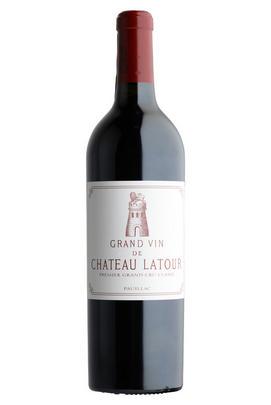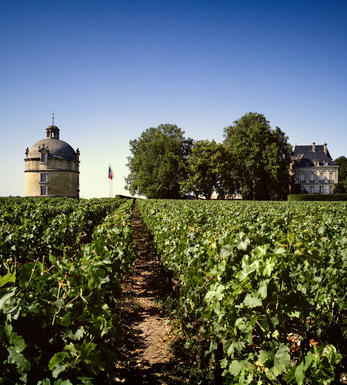
2014 Château Latour, Pauillac, Bordeaux

Critics reviews
The 2014 Latour captures the personality of the year in its linear, lithe construction. It's a decidedly understated Latour that is more about finesse than brawn. Bright red cherry/plum fruit, spice, mint and sweet tobacco open over time, but at this level, wines are more about a feel, an expression of place and a vintage. The 2014 Latour embodies all the best this cool, late-ripening growing season had to offer. I loved the 2014 when it was first shown, about five years ago, and I love it today. It is a super-classic Pauillac.
Drink 2026 - 2064
Antonio Galloni, Vinous.com (January 2022)
The depth, power and just sheer confidence of Latour shines through. This is an extremely classic 2014 - everything in focus, with clarity, grip and poise, sculpted blackcurrant and blackberry fruits, touches of raspberry leaf and crushed rocks. Cabernet Sauvignon dominant, still strict and muscular in its tannins, with heft and width through the palate. As it opens graphite, violet and campfire smoke curls through the centre of the wine, along with slow and steady waves of saffron and sage spice.
Easily one of the wines of the vintage, and one to take your time with, allowing the slow progression of flavours and textures to unroll at their own pace. It will benefit from another few years in bottle before really getting underway, and has decades ahead. Eric Boissenot consultant, Hélène Génin technical director. Harvest September 18 September to October 15.
Drink 2027 - 2045
Janer Anson, JaneAnson.com (February 2022)
Tasted blind. Big and bold and spicy with intensity. So much on the end! Massive density. Dry tannins but luscious fruit too. Really pure and so Pauillac!
Drink 2026 - 2050
Jancis Robinson MW, JancisRobinson.com (February 2018)
The 2014 Latour, which was bottled in July 2016, but of course will not be released for several years depending upon subsequent vintages, has a very pure, tightly-wound bouquet with blackberry fruit infused with black olive and graphite, just as it was out of barrel during en primeur. After several minutes, it is joined by subtle hints of pressed violets. The palate is medium-bodied with fine tannin.
This is very classic in style, exhibiting superb freshness and harmony, the texture perhaps a little silkier than I recollect from barrel. It fans out with a very attractive marine influence that it shares with its neighbor Léoville Las-Cases, whilst the persistence is very impressive and reinforces its First Growth pedigree. This should be a quintessential Latour once released: aristocratic and noble.
Drink 2025 - 2055
Neal Martin, Wine Advocate (March 2017)
So much violets, licorice, pencil, flowers and currants define this on the nose before it moves to fresh mushrooms. It’s full-bodied yet compacted with tension and a compressed center palate. Incredible, fine-grained tannins and energy. The length is truly great. Should be even more beautiful in 2024. Give it time.
James Suckling, JamesSuckling.com (October 2019)
My Left Bank wine of the vintage. Superb cassis fruit from 89.9% Cabernet Sauvignon yet almost understated for Latour. Wonderful ripe texture and chalky tannins, the 'Latour soil' showing more than the 'Latour style' of the past. Pure Cabernet over pure gravel, beautifully expressed.
Drink 2022 - 2050
Steven Spurrier, Decanter.com (April 2015)
Deeper, richer, more concentrated, and stately than the Les Forts De Latour, the 2014 Château Latour is the wine of the vintage from the Médoc. Possessing a flawless, full-bodied, sexy and surprisingly open style on the palate, it’s relatively closed aromatically and only reluctantly gives up notes of cassis, chocolate, and lead pencil shavings. With incredible tannin quality, a layered, concentrated mid-palate, perfect balance and a great finish, it’s a classic Latour, as well as one of the few 2014s that demands cellaring. Hide bottles for 5-7 years and I suspect it will continue drinking nicely over the following three decades.
Drink 2023 - 2053
Jeb Dunnuck, JebDunnuck.com (November 2017)
About this WINE

Château Latour
Château Latour is a wine estate in Pauillac, part of the Haut-Medoc sub-region on the Left Bank of Bordeaux. The estate’s history dates back to at least the 14th century, though vineyards were not established here until the 17th century. The estate is located at the southern edge of the Pauillac appellation, bordering the St Julien vineyards of Château Léoville Las Cases. Latour is one of the five First Growths of the 1855 classification, occupying the top tier alongside Châteaux Lafite Rothschild, Margaux, Haut-Brion, and Mouton Rothschild.
Latour is owned by François Pinault, one of France’s wealthiest people. It forms the jewel in the crown of Pinault’s Artémis Domaines, itself part of the larger Groupe Artémis. Other wineries within the portfolio include Clos de Tart and Domaine d’Eugénie in Burgundy; Château Grillet in the Rhône Valley; Champagne Jacquesson; Eisele Vineyard in California’s Napa Valley; and Maisons et Domaines Henriot, which includes holdings in Champagne, Burgundy, and Oregon.
The day-to-day running of Latour is entrusted to the dynamic Frédéric Engerer. Under his stewardship, a major programme of investment has taken place. In 2012, Latour announced that it would no longer offer its wines as part of the Bordeaux En Primeur campaign. Instead, the wines are kept at the estate until such a time as they are ready to be opened and enjoyed. They are then offered through the La Place de Bordeaux distribution system several years after the vintage.
There are three wines produced here. Château Latour, the grand vin, is produced from vines immediately surrounding the château, from the vineyard area known as L’Enclos. Les Forts de Latour, the second wine, was created in 1966. It is now regarded as a great wine in its own right, certainly worthy of Classified Growth status. A third wine, Pauillac de Latour, is usually the product of young vines.
The vineyard is planted to a majority of Cabernet Sauvignon, along with some Merlot and small amounts of Cabernet Franc and Petit Verdot.

Pauillac
Pauillac is the aristocrat of the Médoc boasting boasting 75 percent of the region’s First Growths and with Grand Cru Classés representing 84 percent of Pauillac's production.
For a small town, surrounded by so many familiar and regal names, Pauillac imparts a slightly seedy impression. There are no grand hotels or restaurants – with the honourable exception of the establishments owned by Jean-Michel Cazes – rather a small port and yacht harbour, and a dominant petrochemical plant.
Yet outside the town, , there is arguably the greatest concentration of fabulous vineyards throughout all Bordeaux, including three of the five First Growths. Bordering St Estèphe to the north and St Julien to the south, Pauillac has fine, deep gravel soils with important iron and marl deposits, and a subtle, softly-rolling landscape, cut by a series of small streams running into the Gironde. The vineyards are located on two gravel-rich plateaux, one to the northwest of the town of Pauillac and the other to the south, with the vines reaching a greater depth than anywhere else in the Médoc.
Pauillac's first growths each have their own unique characteristics; Lafite Rothschild, tucked in the northern part of Pauillac on the St Estèphe border, produces Pauillac's most aromatically complex and subtly-flavoured wine. Mouton Rothschild's vineyards lie on a well-drained gravel ridge and - with its high percentage of Cabernet Sauvignon - can produce (in its best years) Pauillac's most decadently rich, fleshy and exotic wine.
Latour, arguably Bordeaux's most consistent First Growth, is located in southern Pauillac next to St Julien. Its soil is gravel-rich with superb drainage, and Latour's vines penetrate as far as five metres into the soil. It produces perhaps the most long-lived wines of the Médoc.
Recommended Châteaux
Ch. Lafite-Rothschild, Ch. Latour, Ch. Mouton-Rothschild, Ch. Pichon-Longueville Baron, Ch. Pichon Longueville Comtesse de Lalande, Ch. Lynch-Bages, Ch. Grand-Puy-Lacoste, Ch, Pontet-Canet, Les Forts de Latour, Ch. Haut-Batailley, Ch. Batailley, Ch. Haut-Bages Libéral.

Cabernet Sauvignon Blend
Cabernet Sauvignon lends itself particularly well in blends with Merlot. This is actually the archetypal Bordeaux blend, though in different proportions in the sub-regions and sometimes topped up with Cabernet Franc, Malbec, and Petit Verdot.
In the Médoc and Graves the percentage of Cabernet Sauvignon in the blend can range from 95% (Mouton-Rothschild) to as low as 40%. It is particularly suited to the dry, warm, free- draining, gravel-rich soils and is responsible for the redolent cassis characteristics as well as the depth of colour, tannic structure and pronounced acidity of Médoc wines. However 100% Cabernet Sauvignon wines can be slightly hollow-tasting in the middle palate and Merlot with its generous, fleshy fruit flavours acts as a perfect foil by filling in this cavity.
In St-Emilion and Pomerol, the blends are Merlot dominated as Cabernet Sauvignon can struggle to ripen there - when it is included, it adds structure and body to the wine. Sassicaia is the most famous Bordeaux blend in Italy and has spawned many imitations, whereby the blend is now firmly established in the New World and particularly in California and Australia.


Buying options
Add to wishlist
Description
The 2014 Latour captures the personality of the year in its linear, lithe construction. It's a decidedly understated Latour that is more about finesse than brawn. Bright red cherry/plum fruit, spice, mint and sweet tobacco open over time, but at this level, wines are more about a feel, an expression of place and a vintage. The 2014 Latour embodies all the best this cool, late-ripening growing season had to offer. I loved the 2014 when it was first shown, about five years ago, and I love it today. It is a super-classic Pauillac.
Drink 2026 - 2064
Antonio Galloni, Vinous.com (January 2022)
wine at a glance
Delivery and quality guarantee